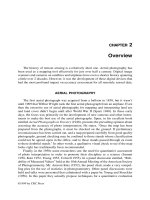International bussiness the challenge of global competition 11e chapter 06
Bạn đang xem bản rút gọn của tài liệu. Xem và tải ngay bản đầy đủ của tài liệu tại đây (497.69 KB, 40 trang )
chapter six
Sociocultural Forces
McGraw-Hill/Irwin
International Business, 11/e
Copyright © 2008 The McGraw-Hill Companies, Inc. All rights reserved.
Learning Objectives
Explain the significance of culture for international
business
Identify the sociocultural components of culture
Discuss the significance of religion to businesspeople
Explain the cultural aspects of technology
Discuss the pervasiveness of the Information Technology
Era
6-3
Learning Objectives
Explain the importance of the ability to speak the
local language
Discuss the importance of unspoken language in
international business
Discuss the two classes of relationships within a
society
Discuss Hofstede’s four cultural value
dimensions
6-4
Rules of Thumb for Cross Culture Business
• Be prepared
• Slow down
• Establish trust
• Understand the importance of language
• Respect the culture
• Understand the components of culture
6-5
What is Culture
• The sum total of beliefs, rules,
techniques, institutions, and
artifacts that characterize human
populations
–
–
–
–
Learned
Interrelated
Shared
Defines the boundaries
6-6
Ethnocentricity
• Ethnocentricity
– Belief in the superiority of one’s own
ethnic group
6-7
Living with Other Cultures
• Realize that there are many different cultures
• Learn the characteristics of those cultures
– Spend a lifetime in a country
– Do training program
6-8
Culture Affects All Business Functions
• Marketing
– Variation in attitudes
and values requires
firms to use different
marketing mixes
• P&G Japanese
Camay commercials
• Disneyland Paris
• Human Resource
Management
– Evaluation of
managers
• Production and
Finance
– Attitudes toward
authority
– Attitudes toward
change
6-9
Sociocultural Components
• Culture is:
– Aesthetics
– Attitudes and beliefs
– Religion
– Material Culture
– Language
– Societal organization
– Legal characteristics
– Political structures
6-10
Aesthetics
• Culture’s sense of beauty and good taste
– Art conveys meaning
• Colors, symbols, numbers--Nike air
• Architectural style differences
• feng shui
• Music and Folklore
– Musical tastes vary
– Folklore discloses way of life
• Cowboys in Chile or Argentina
• Mexican singing cricket
6-11
Attitudes and Beliefs
• Attitudes Toward Time
– Vary across cultures
– Difficult area for some
Americans
– Directness and drive
• Perceived to be rudeness
– Deadlines
• Liability abroad
6-12
Attitudes Toward Achievement and
Work
• Germans put leisure first and work second
• The demonstration effect
– Result of having seen others with desirable goods
• Job Prestige
– The distinction between blue-collar workers and
office employees
6-13
Religion
• Responsible for many of the attitudes and beliefs
affecting human behavior
– Work Ethic
• Protestant work ethic
– Duty to glorify God by hard work and the
practice of thrift
• Confucian work ethic
– Drive toward hard work and thrift; similar to
Protestant work ethic
6-14
Will this work?
6-15
Primary Asian Religions
Hinduism
– Caste system
• entire society is divided into four groups (plus the outcasts) and
each is assigned a certain class of work
• Buddhism
– Reform of Hinduism
• Jainism (Mahavira a contemporary of Buddha)
– Nonviolence a major principle
• Sikhism
– Bridge between Hinduism and Islam
6-16
Primary Asian Religions, cont’d.
• Confucianism
– Inseparable from Chinese culture
• Taoism
– Lao Tzu, contemporary of Confucius
• Shintoism
– Indigenous to Japan
6-17
Islam
• Five Pillars of Faith
• Youngest and second
largest faith
–
–
1.3 billion followers
Comparison: Christianity has 2 billion
adherents
• Muhammad is Founder
– Prophet of God and head of
state
• Holy Book Koran
–
–
–
–
–
Confession of faith
Five daily prayers
Charity
Ramadan fast
Pilgrimage to Mecca
• Jihad – holy war
• Sunni-Shia Conflict
– Conflict gives rise to violent
clashes
6-18
Religious Population of the World
Insert Figure 6.1
6-19
Animism
• Spirit worship, incl. magic, witchcraft
• Everything in nature has its own spirit or divinity
6-20
Material Culture
• Material Culture
– All human-made objects
– concerned with how people make things
(technology) and
– who makes what and why (economics)
6-21
Technology
• Technology
– Mix of usable knowledge that society applies and
directs toward attainment of cultural and economic
objectives
6-22
Importance of Technology
– Enables a firm to be
competitive in world
markets.
– Can be sold or be
embodied in the
company’s products
– Can give a firm
confidence to enter a
foreign market
– Enables the firm to obtain
better than usual
conditions for a foreign
market investment
– Enables a company with
only a minority equity
position to control a joint
venture
– Can change the
international division of
labor
– Causes major firms to
form competitive alliances
6-23
Material Culture - Technology
• Cultural Aspects
of Technology
– Includes skills in marketing,
finance, and management
– People not always ready to
adapt to changes
technology brings
• Technological
Dualism
– The side-by-side presence
of technologically
advanced and
technologically primitive
production systems
• Appropriate
Technology
– The technology (advanced,
intermediate, or primitive) that
most closely fits the society
using it
• Boomerang Effect
– Situation in which technology
sold to companies in another
nation is used to produce
goods to compete with those
of the seller of the technology.
6-24
Information Technology
• Information Technology Era
– As early as 2000 the Internet economy
• had reached $850 billion
• exceeded the size of the life insurance and real
estate industries
6-25









